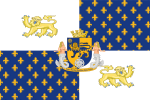Sangria Islands
Loading map... |
The Sangria Islands, officially the Republic of the Sangria Islands (Sangrìnensa: Ripubleca de las Ilas Sangrìanas) and also known as the Sangrias, is a small sovereign island state in the centre of the Sea of Mojaca. Culturally and geopolitically part of southwestern Uletha, the Sangria Islands are in closest proximity to Libérie Franque to the west, Alora to the east, and Onnutu to the south. The Sangria Islands consist entirely of the Sangrian Archipelago, with three main islands. The largest and most populated island is Ila de la Corána de la Sahìa (commonly Sahìa), dominated by the 3,000 metre Monte de Táma, an extinct volcano. The second largest is Ila de la Tiára de la Beciána (commonly Beciàna), followed by Ila de la Diadima de la Prìncipe (commonly Prìncipe). The country has a total land area of 5155.65 km² with a population of approximately 262,020 inhabitants. The country's capital, Porta de Sangria (Sangrìnensa: Porta de Sangrìa) shares its name with the archipelago. The Sangrias are a semi-presidential unitary republic, headed by the President (Sangrìnensa: "Presadent(e/a)") of the Executive, alongside a Prime Minister (Sangrìnensa: "Prìmu Menistèra") of the Legislature. The Sangria Islands are a member of the Association of South Ulethan Nations and the Assembly of Nations.
Etymology
History
Bronze Age
Iron Age
Classical Antiquity
Late Antiquity
1st Century: The Romantish Empire arrives around the year 110 AD, becoming the first of many foreign powers to control the small island chain.
7th Century: Mazan, following the crumbling of the Romantish Empire, invades and annexes the land for its ever growing Caliphate. However, control is loose, and the territory acts in many ways as a sovereign nation paying tribute to the Mazanids.
Middle Ages
13th Century: The crusading Ulethan nations (Franqueterre, Castellan, Plevia, Navenna, Florescenta) invade and occupy the islands to secure a stopping point on the way to take the Kalkaran Straits. A small independent Crusader kingdom is established by a family of Castellanese nobles in the islands following the eventual departure of the Ulethan powers.
15th Century: Castellan unilaterally annexed the territory (after ?), raising a dispute with Franqueterre to last for centuries. The area could have been considered Castellan's first true colonial venture, however they were annexed and subsequently became a full province within the nation. The Sangria Islands would never receive the status of a colony.
Early Modern Era
Early 1800s: The first buildings, roads, and modern ports were constructed during the early 1800s. Loads of immigrants seeking better conditions arrived on the islands, cheap labour sourced from poorer lands like Iscu, Tolulu, and Telkarnatha.
18__: Following centuries of Castellanese rule, Franqueterre (in its Napoleon era?) invaded and illegally annexed the islands for its empire. Following the Franqueterran defeat, the islands were returned to Castellan ending years of occupation. Franqueterre fails to relinquish its claim to the islands after its departure.
Late Modern Era
1930s: During the Castellanese Civil War, Franqueterre invades and occupies the islands. After the war ends, Franqueterre refuses to recede the islands to Castellan until a Castellanese naval contingent retakes them by force.
1940s: Plevian immigrants form a small diaspora on the island as a result of the ongoing Great War, invigorating a hotel and services sector on the islands. The Plevian language following this point slowly became a minority contributor to the Sangrianese language once again. The Castellanese, following a full occupation of the mainland (by their enemies) during the Great War set up an interim capital at Porta de Sangrìa, quickly and successfully fortifying the islands.
1950s: The Sangrias gain the right of home rule, being upgraded to an autonomous province of Castellan from a standard one. The Islands gain the right to oversee everything that pertains to their lands except for foreign relations, defence, environmental matters, health services, monetary matters, as well as oversight over the Sangrian legal system despite the islands receiving full control over their legal affairs.
1960s: As the wave of revolutions in Ulethan colonies begins to sweep the world, unrest and eventually riots break out in Porta de Sangrìa due to varying issues such as inequality with Castellan, exploitation of the islands, Castellanese control over the health and environmental sectors, and more. Despite being quelled peacefully, these pro-independence efforts eventually coalesce into a strong anti-colonial and pacifist movement.
1970s: The islands officially declare independence as the Republic of the Sangria Islands, following the election of a pro-independence majority to the Sangrian parliament. The Sangrias join the AN and ASUN as an independent nation. Franqueterre is forced to relinquish their claim to the islands. This move came with the advent of air travel and a massive tourism boom for the islands, granting them self-sufficiency with funds from tourism as well as other local industries such as fishing and limited mineral extraction.
Present-Day: As an independent first world nation situated in the near centre of the Sea of Mojaca, the Islands reap in benefits from trade, shipping, fishing, and tourism. An idyllic island paradise, the tourism sector is one if not the biggest sources of revenue for the nation. Visitors to the islands often come for the majestic colonial and medieval-era architecture and for its beaches. The Republic has also become a personal tax haven, neglecting to impose income tax on its citizens and a smaller tax on immigrants and expatriates. Corporations however are often not permitted to set up any sort of office or factory on the islands due to strict ecological and environmental protection laws stemming from the original draft of the Republic's constitution regarding the environment. However, if a corporation can pass the strict requirements for setting up shop on the Islands, they will be levied a small corporate tax and reap large benefits.



